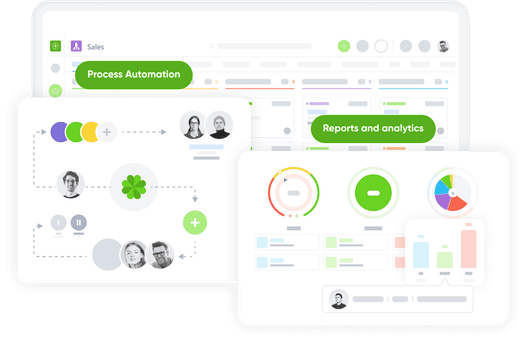Sales Pipeline Building: A Step-by-Step Guide for Success
In the realm of sales, the term "sales pipeline" is frequently bandied about.

If you're engaged in sales discussions, you'll often encounter phrases like “getting prospects into the pipeline,” “expanding your pipeline,” and “filling your pipeline with promising leads.”
However, it's important to recognize that “pipeline” is more than just a trendy buzzword. Instead, it's a pivotal sales tool for any sales management operation, capable of making a substantial impact on your financial results.
The stages comprising a sales pipeline serve as a vital aid in comprehending your sales process for you and your team. This visual representation illustrates where your deals stand within the sales funnel, identifies points where deals may be encountering obstacles, and pinpoints the sales activities that contribute most significantly to your representatives closing deals and generating revenue.
If you're not utilizing a sales pipeline, you could be missing out on valuable insights regarding the effectiveness of your sales process and the current status of your deals.
In the following article, we will elucidate the concept of sales pipelines, dissect the various stages within them, elucidate how adept management of your sales pipeline can enhance your chances of meeting your sales objectives, and guide you through the process of constructing your very own sales pipeline.
The Importance of Sales Pipelines: Monitoring and Maximizing Sales Success
A sales pipeline serves as an organized and visual method for monitoring potential buyers as they progress through distinct stages within the purchasing process and their buyer's journey.
Typically, sales pipelines are represented as a horizontal bar or, sometimes, as a funnel, divided into various stages aligning with a company's sales process. Leads and prospects advance from one stage to another as they navigate the sales journey. This progression occurs, for instance, when sales representatives receive responses to outreach efforts like cold emails or when potential customers are categorized as qualified or unqualified leads.
Sales pipeline stages serve a vital purpose by introducing a layer of accountability and simplifying the achievement of sales objectives. They break down the sales process into manageable, trackable tasks.
With a sales pipeline, salespeople gain clear visibility into the status of their earnings, deals, and other sales endeavors at all times. This visibility is essential because sales professionals often handle numerous sales prospects and deals simultaneously, making it crucial not to overlook any opportunities.
Furthermore, a sales pipeline proves to be a potent tool for sales managers. It enables them to collect and analyze data regarding the efficacy of their sales process, facilitating optimization as needed. As the sales pipeline tracks a salesperson's activities, it offers insights into which sales activities yield the highest returns for the company.
Michelle Seger, a partner at Atlanta-based SalesGlobe, emphasizes the significance of this approach, stating, “Companies don't know what their possibilities are. If you can actually review your activities, their durations, and your conversion rates, it provides clarity about your current position and highlights areas that require improvement.”
Key Elements for an Effective Sales Pipeline: Preparing for Success
Before embarking on the construction of your own sales pipeline, it's essential to have certain key elements in place to ensure its effectiveness. As a pivotal sales tool, the preparation is crucial. Here are the fundamental prerequisites you should have at your disposal before initiating the creation of each stage within your sales pipeline:
Prospective Buyer List: Start by compiling a comprehensive list of potential buyers. Understanding your target audience is the foundation of an efficient sales pipeline.
Sales Team's Process: Familiarize yourself with your sales team's established process. This knowledge will serve as the framework upon which your pipeline is built, aligning it with your team's specific workflow.
Revenue Targets: Clearly defined revenue targets are vital. Having these objectives in place will allow you to gauge your progress and measure your pipeline's effectiveness in meeting your financial goals.
Scheduled Meetings with Colleagues: Collaboration within your team is crucial. Schedule meetings with colleagues to gather insights, align strategies, and ensure that your sales pipeline harmonizes with the broader organizational goals.
To effectively build your sales pipeline, let's delve into each crucial component, starting with the list of prospects:
1. A List of Prospects:
Begin by curating a list of potential prospects who closely align with your target audience and ideal customer profile (ICP). These prospects should exhibit a genuine need for the product or service you're offering and have the financial means (budget) to make a purchase.
Ensure that your list is meticulously crafted to mirror your buyer personas. It should encompass comprehensive details, including:
Names and contact information.
Details about their company, such as the industry they operate in and the size of their business.
Information about their role within the organization.
Clarity on whether they hold decision-making authority.
Insights into the initial point of contact, whether it was initiated by you or vice versa.
Identification of their pain points and challenges.
If you have already engaged with these prospects, consider assigning them a tentative pipeline stage. Be flexible in this regard, as you can refine and adjust these stages as your interactions progress.
Building this comprehensive prospect list is the foundational step in constructing an effective sales pipeline. It ensures that you're targeting individuals or businesses that are not only potential customers but also align with your product or service offerings.
2. Your Sales Process:
A well-defined sales process is the backbone of your sales pipeline. It provides your sales team with a structured roadmap, outlining each step and activity required to guide a prospect from initial contact to a closed deal. A robust sales process empowers your sales representatives to consistently secure successful deals by simply adhering to the defined steps and activities within their workflow.
If your sales team already has a clearly defined sales process in place, you're on the right track. Chances are, the steps within your sales process correspond closely with the stages in your sales pipeline. This alignment ensures that your team's efforts are methodical and systematic, optimizing their chances of closing deals effectively.
However, if you haven't yet established a defined sales process, there's no need to be concerned. As you progress in building each stage of your sales pipeline, as we will explore in the following sections, you will simultaneously have the opportunity to map out your sales process. This iterative approach allows you to tailor your sales process to align seamlessly with your pipeline, ensuring a cohesive and efficient sales strategy.
3. Your Revenue Targets:
Setting clear revenue targets is a fundamental aspect of designing a successful sales pipeline. Your sales pipeline serves as a strategic tool to help you achieve these financial objectives. Therefore, it's essential to have your revenue goals established and readily available.
These revenue targets play a crucial role in answering a pivotal question: How many deals must you add to your pipeline to reach your financial objectives? By having a clear understanding of the conversion rate of your qualified leads into new customers, you can easily calculate the number of deals required at each stage of your pipeline to meet your revenue goals effectively.
4. Your Colleagues:
A sales pipeline isn't just an individual tool; it's a collaborative one that enhances both individual and team-wide task management and tracking. Since all members of your sales team will utilize the same pipeline, it's imperative to involve your team in the decision-making process as you construct it.
By including your colleagues in this process, you create an environment where everyone can contribute their insights and recommendations. This collaborative approach enriches your sales pipeline, making it a more potent tool for fostering teamwork, facilitating communication, and streamlining project management within your sales team.
Defining Your Sales Pipeline Stages:
Sales pipelines vary from one business to another, as they are tailored to suit the unique characteristics and needs of each organization. While some companies might employ a five-step pipeline, others opt for more complex structures with as many as eight stages, and still, others find success with seven stages. The choice of the number and type of stages in your sales pipeline hinges on several factors, including your approach to lead contact and the nature of your product or service.
Here are some examples of common sales pipeline stages, along with explanations for each:
a. Initial Contact: This stage marks the beginning of your engagement with a lead. It often involves the first outreach or interaction, such as a cold call, email, or a lead's response to marketing efforts.
b. Qualification: At this stage, leads are evaluated to determine if they meet the criteria of your ideal customer profile. It involves assessing factors like interest, budget, and fit with your product or service.
c. Needs Analysis: This stage focuses on understanding the prospect's specific needs and pain points. It enables you to tailor your solution to address their unique challenges effectively.
d. Presentation/Demonstration: Salespeople may showcase their product or service to prospects in this stage, providing a clear and compelling overview of how it can solve the lead's problems.
e. Proposal: Here, a formal proposal is created, detailing the terms and conditions of the proposed deal. It outlines the scope of work, pricing, and any other relevant details.
f. Negotiation: During negotiations, any objections or concerns raised by the lead are addressed. The goal is to find common ground and ensure both parties are satisfied with the proposed terms.
g. Closing: The final stage involves securing a commitment from the lead to move forward with the purchase. It marks the successful conclusion of the sales process.
While these stages are common to many sales pipelines, they can be customized and expanded upon to suit your specific business and industry. For instance, as mentioned earlier, SaaS sales may include a product demonstration stage, while car sales may incorporate a test drive phase.
Prospecting:
Prospecting is the initial stage in your sales pipeline and is vital to your organization's success. The approach to prospecting can vary significantly depending on factors such as your target clients, the products or services you offer, and your organizational structure. Here are some key insights into this crucial stage:
Diverse Approaches: Different organizations employ various methods for prospecting. Some may have dedicated lead generation teams solely focused on sourcing new leads, while others may rely primarily on marketing campaigns that leverage downloadable content, social media engagement, and email marketing.
Universal Objective: Regardless of the specific approach, the primary goal of the prospecting stage remains consistent: identifying potential buyers who have a genuine need for what you're offering.
Qualifying:
Qualifying, sometimes referred to as “research,” is the stage where you determine if a prospect is the right fit for your product or service. While this step can occur at various points in the sales process, it's often conducted after initial contact has been made with a potential customer. Here's what you need to know about this essential stage:
Efficient Resource Allocation: Lead qualification is a critical step to ensure your sales professionals spend their time wisely. It helps prevent them from pursuing leads that are unlikely to buy your product, ensuring resources are allocated efficiently.
Key Considerations: During lead qualification, you assess several important factors:
Does the prospect have the budget for your product or service?
Can the prospect make the purchasing decision independently, or do they need approval from someone else?
Is there a genuine need for your product or service?
Is the prospect ready to make a purchase at this time?
Determining Fit: If any of these questions receive negative responses, the lead may not be a suitable fit for your offering. In other words, they may be categorized as “cold” leads.
Qualifying leads is a crucial step to ensure your sales team focuses their efforts on leads with a high likelihood of conversion, ultimately increasing efficiency and boosting your chances of closing deals successfully.
Handling cold leads is a fundamental aspect of effective sales management. It's important to understand that cold leads can still hold value, but they should not occupy valuable space in your active pipeline. Instead, consider archiving their contact information or relocating them to a separate category, especially if your CRM system supports multiple pipelines.
The Pareto Principle, often referred to as the 80/20 rule, highlights that approximately 20% of your leads will contribute to 80% of your revenue. When you encounter a prospect who has been lingering in your pipeline for longer than your typical sales cycle, it's prudent to reclassify them. You might place them in a different category, such as a future pipeline or a callback list, and set a reminder for a future
To streamline and expedite this process, consider harnessing the capabilities of a CRM with a “deal-rotting” feature, which can automate the management of such leads, freeing up your time for more productive tasks.
By implementing these strategies, you ensure that your active sales pipeline remains focused on promising opportunities, while simultaneously maintaining a structured approach to
Incorporating automation tools and intelligent CRM features aligns with modern sales practices, allowing you to optimize your sales efforts efficiently.
The process of engaging with prospects and building fruitful relationships is a pivotal aspect of effective sales management. Let's break down these stages:
Initiating Contact: This step involves the initial outreach to a prospect. Sales professionals may employ various communication channels such as phone calls, emails, social media interactions, text messages, or face-to-face meetings. However, before making contact, it's crucial to conduct thorough research during the qualification stage. Utilize the valuable insights gathered to tailor your approach effectively, especially when targeting specific segments.
For a helping hand in initiating conversations, consider leveraging our cold calling sales scripts to kickstart engagement and forge connections.
Fostering Relationships: Successful sales go beyond mere transactions; they require demonstrating a genuine understanding of the prospect's needs right from the first interaction. Sales representatives should focus on nurturing potential buyers and cultivating relationships throughout the entire buyer's journey.
Lead nurturing doesn't equate to bombarding clients with constant calls or emails. It can be as simple as sharing relevant articles that address the prospect's unique challenges or engaging with their social media content, like posts on LinkedIn. It's about actively listening to objections and providing honest responses. The ultimate aim is to establish trust with your prospects, making them comfortable and confident in doing business with you.
This phase of the sales pipeline often spans multiple stages, contingent upon the number of touchpoints required to convert leads and prospects into loyal customers.
Once your sales representatives have initiated contact, explained your product, and built trust, it's time to bring the deal to a close.
The approach to requesting a sale may vary depending on your sales team, organization, and customers. In some instances, the customer may readily agree. In other cases, you might need to make concessions to secure the sale, but it's crucial to pre-approve those concessions.
If a customer goes silent just before finalizing a deal, make several contact attempts, and then send a message acknowledging that you understand it might not be the right time, and they are welcome to reach out when they are ready.
Afterward, categorize that contact as a cold lead, ensuring your pipeline remains streamlined and focused on promising opportunities.
Reengaging Cold Leads:
Indeed, recontacting cold leads should be a dedicated stage within your sales pipeline. Just because they weren't prepared to make a purchase during the initial contact doesn't mean their circumstances haven't changed.
Periodically checking in with them serves a dual purpose – it contributes to building and maintaining relationships, as well as potentially uncovering new opportunities. Your
Moreover, this reengagement stage provides an excellent opportunity to reassess your approach across the previous stages of the sales process. It's possible that many of these leads remained cold due to a lack of effective communication regarding their problems and your solution. By revisiting and fine-tuning your messaging, you can increase the chances of reigniting their interest.
By integrating this strategic approach into your pipeline, you ensure that cold leads are not overlooked but rather viewed as potential future opportunities, enhancing your overall sales effectiveness.
The sales pipeline typically consists of several key stages, each serving a specific purpose in the sales process. Here's a breakdown of these stages:
Prospecting: This is the initial stage where you identify potential customers or leads. It involves researching and finding individuals or businesses that may have an interest in your product or service.
Lead Generation: In this stage, you actively generate interest from potential customers. This can be through various means like marketing campaigns, content marketing, social media outreach, and more.
Qualifying Leads: After generating leads, it's essential to assess their quality. Not all leads will be equally valuable. Qualification involves determining if a lead has the budget, authority, need, and timeline (BANT) to potentially become a customer.
Engagement (Contacting Leads): This stage involves making initial contact with the leads. Sales representatives reach out to prospects through methods like phone calls, emails, social media messages, or
in-person meetings.Nurturing (Building Relationships): Building and maintaining relationships with leads is crucial. This stage focuses on providing value to prospects, addressing their needs, and gradually gaining their trust. It often involves ongoing communication and personalized interactions.
Conversion (Closing): Once a strong relationship is established and the prospect is ready, the salesperson presents the product or service and seeks to close the deal by getting the prospect to make a purchase.
Implementation and Onboarding (B2B): In business-to-business (B2B) sales, particularly for complex products or services, there may be additional stages involving implementation and onboarding. This includes assisting the customer in successfully integrating and using the product or service.
Follow-Up with Cold Leads: As mentioned, this stage is dedicated to reengaging with cold leads who may not have been ready to buy initially but might be interested later on. Regular follow-ups and continued relationship-building are key in this stage.
These stages can vary slightly depending on the specific industry, company, or sales process. However, they form the fundamental framework for managing and progressing leads through the sales pipeline.
Creating an Effective Sales Pipeline for Your Organization:
Creating and managing a sales pipeline is crucial for efficiently tracking and converting potential customers into paying clients. Here's a step-by-step guide to help you establish an effective sales pipeline for your organization:
Step 1: Identify Your Prospective Buyers
Begin by compiling a list of potential customers who may be interested in your product or service.
If you have a manageable number of leads (fewer than 10) or are just starting out, you can use spreadsheet tools like Google Sheets or Excel to track your leads and interactions. Alternatively, consider using dedicated sales Customer Relationship Management (CRM) software for more efficient lead management.
CRMs offer benefits such as collaborative deal management, easy movement of deals between pipeline stages, and integration with prospects' contact information. They also enable sales managers to monitor the progress of the entire team toward revenue goals.
Step 2: Define Your Sales Pipeline Stages
Break down your sales process into manageable stages that focus on sales activities. This approach helps sales representatives stay focused on their daily tasks and activities, ultimately contributing to closing deals.
Consider common sales activities and those with the most impact on sales when setting up your pipeline stages.
You can use predefined sales pipeline stages as a starting point or tailor the stages to align with your specific sales process and strategy.
Step 3: Continuously Refine Your Stages
As you start using your sales pipeline, pay attention to recurring types of conversations between your sales team and prospects.
Adjust and refine your pipeline stages to accommodate these recurring interactions. For example, if you frequently deal with nervous buyers in real estate, you might introduce a “reassure buyer” stage.
Both your marketing and sales teams should collect relevant sales metrics to inform the ongoing refinement of your pipeline stages.
Step 4: Maintain Pipeline Accuracy
Encourage your team to develop the habit of consistently entering new contacts and deals into the pipeline and moving them through the stages.
Treat pipeline stages as a
Emphasize the importance of regularly updating the pipeline, and over time, it will become an invaluable tool for your team, providing visibility into their progress, tasks, and the current status of each deal.
By following these steps and integrating a well-structured sales pipeline into your organization's sales processes, you can streamline lead management, improve sales team efficiency, and enhance your ability to predict and achieve sales revenue goals.
Bonus Tip: Managing Deal Progression in Your Sales Pipeline
Effectively moving deals from one stage to another in your sales pipeline is crucial for maintaining clarity and ensuring that your team remains productive. Here are some valuable tips on when and how to transition deals between stages:
Clear and Specific Criteria: Establish clear and specific criteria for each stage of your pipeline. This helps prevent confusion about when a deal should progress to the next stage. For instance, in the lead qualification stage, outline the specific conditions that must be met for a lead to be considered qualified. Having well-defined criteria eliminates ambiguity.
Break Down Broad Stages: Consider breaking down broader stages into smaller, more granular steps. This approach simplifies the process and makes it easier to track and manage progress. For example, within the “Making Contact” stage, you could divide it into three distinct stages: “First Contact,” “Set Meeting,” and “Presentation.” This breakdown allows for a more precise assessment of where a deal stands.
Avoid Overcomplication: While granularity is beneficial, avoid having too many stages in your pipeline. If you find that moving deals between numerous stages becomes burdensome and time-consuming, consider consolidating some of them. Your sales pipeline is a valuable tool, but it should not consume all of your sales representatives' time. Streamline the process to maintain focus on high-value activities.
By implementing these strategies, you can ensure that your sales pipeline remains organized and efficient, promoting better visibility into deal progression and ultimately contributing to more successful sales outcomes.
Tools for Building and Maintaining a Sales Pipeline:
Building and managing a sales pipeline can be done with a variety of tools, depending on your specific needs and the complexity of your sales process. Here are some tools and considerations:
Basic Tools: For simple sales pipelines or when you're just starting out, basic tools like sticky notes or an Excel spreadsheet can suffice. They allow you to manually track contacts, deals, and their progress. However, they may become cumbersome as your pipeline grows or if you have a more complex sales cycle.
Customer Relationship Management (CRM) Software: For more efficient pipeline management, especially when dealing with a significant number of contacts and complex sales processes, CRM software is highly recommended. A CRM like Pipedrive offers several advantages:
Contact and Deal Linking: CRM software allows you to associate contacts with specific deals, providing a clear overview of your interactions and progress.
Email Integration: Integration with email correspondence streamlines communication and ensures all relevant information is accessible within the CRM.
Real-Time Sales Data: CRM systems provide real-time insights into your team's sales data, helping you make informed decisions.
Automation: You can automate tasks and reminders to stay on top of your sales activities efficiently.
Customization: Tailor your pipelines to match your unique sales process, and even create separate pipelines for different sales projects or teams.
Activity Logging: Salespeople can easily log their daily activities, mark them as completed, and send emails directly from the CRM platform.
Integration: Many CRMs offer integrations with other software and tools to enhance functionality and streamline processes.
Pipedrive CRM: Pipedrive is an example of a CRM that offers customizable pipelines and an intuitive interface for salespeople. It allows for the management of multiple pipelines, making it suitable for various sales projects or teams. Pipedrive also offers features like call tracking and a marketplace with integrations to further enhance your sales process.
Ultimately, the choice of tools depends on your specific requirements and the size of your sales operation. As your pipeline grows and becomes more complex, transitioning to a CRM like Pipedrive can significantly improve efficiency and help you stay organized.
In conclusion, a well-implemented and effectively managed sales pipeline is a critical tool for your sales team to track deals and activities efficiently. It's essential to tailor your lead pipeline stages to align with the revenue-generating activities of your sales team, and don't hesitate to revise and refine them as needed. A well-honed pipeline increases accuracy and helps you achieve your sales targets.

Oliver Grand
Share





